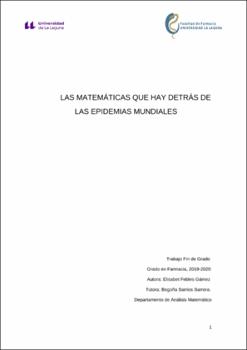Las matemáticas que hay detrás de las epidemias mundiales
Autor
Febles Gámez, ElisabetFecha
2020Resumen
Actualmente estamos sufriendo una crisis sanitaria debido a la gran pandemia
causada por el COVID-19. A lo largo del tiempo la humanidad ha sufrido
diversas pandemias causadas por varias enfermedades como la peste negra,
la viruela o el sida. Muchos matemáticos y epidemiólogos han colaborado, y lo
hacen hoy en día, para comprender que pasará a lo largo del tiempo con estas
enfermedades y cuáles son las mejores medidas para erradicarlas. Hay
diversos modelos matemáticos que se encargan de modelizar el
comportamiento de las mismas. En este trabajo hablaremos de algunos de los
más sencillos y usados como son los modelos compartimentales SI, SIS y SIR,
siendo este último el que se ajusta más a la situación actual del COVID-19. El
objetivo de este trabajo es explicar en qué consisten los anteriores patrones
matemáticos y cómo se utilizan para determinar lo que sucederá a largo tiempo
para así tomar medidas prudentes que nos ayuden a controlar la propagación
de las enfermedades. We are currently experiencing a health crisis due to the major pandemic caused
by COVID-19. Over time, the humanity has suffered various pandemics caused
by various diseases such as black plague, smallpox and AIDS. Many
mathematicians and epidemiologists have collaborated, are still doing
nowadays, to understand what will happen over time with these diseases and
what are the best measures to eradicate them. There are several mathematical
models that are in charge of modeling the behavior of these. In this paper I will
explain some of the simplest and most used as are the compartmental models
SI, SIS and SIR, the latter being the one that best fits the current situation of the
COVID-19. The aim of this work is to explain what the previous mathematical
patterns consist of and how they are used to determine what will happen over a
long time in order to take prudent measures to help us to control the spread of
diseases.





